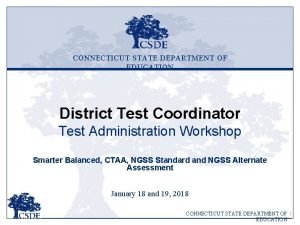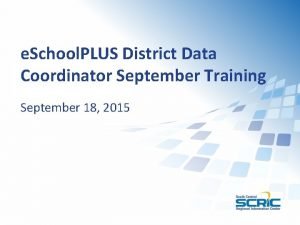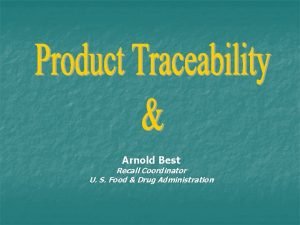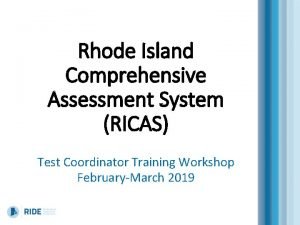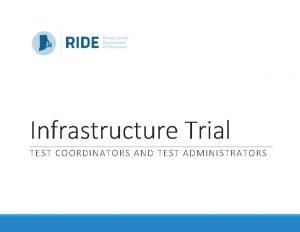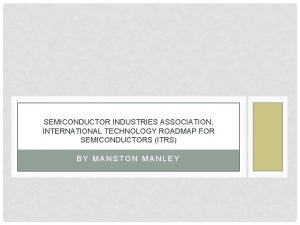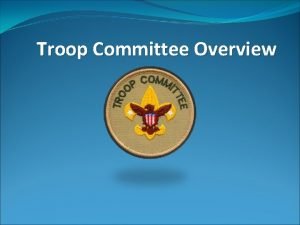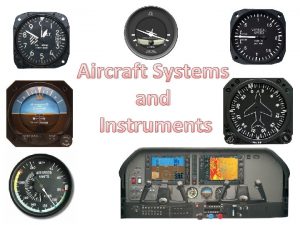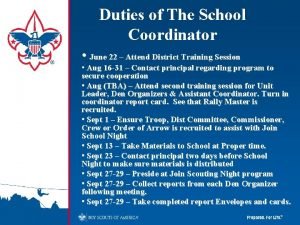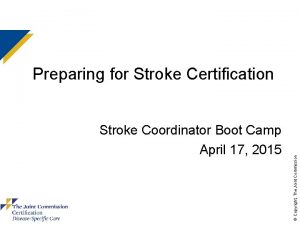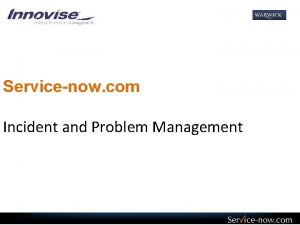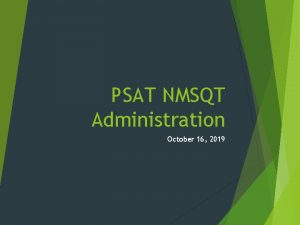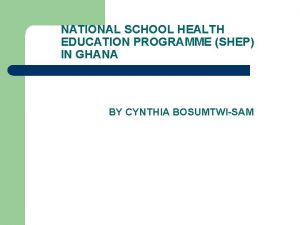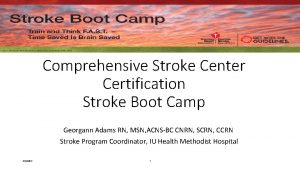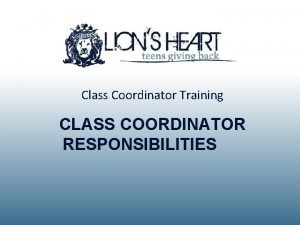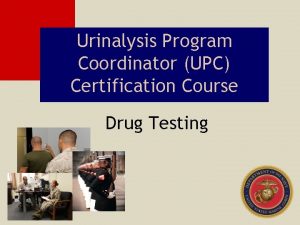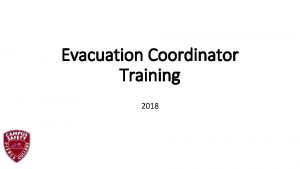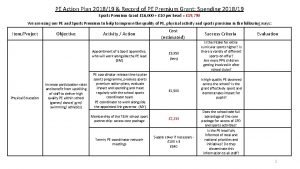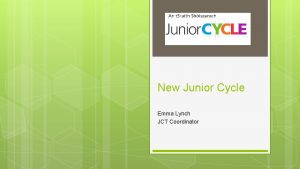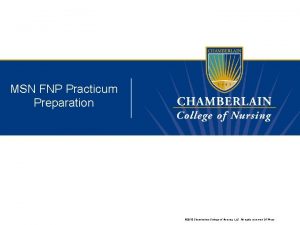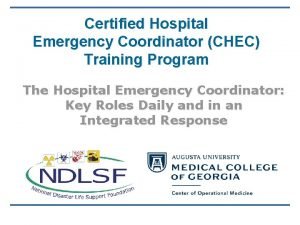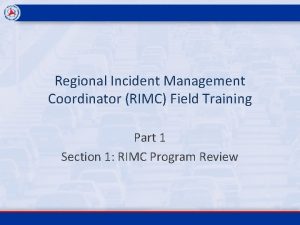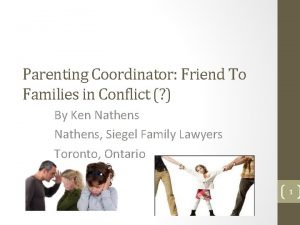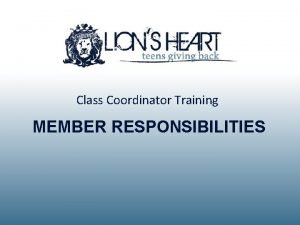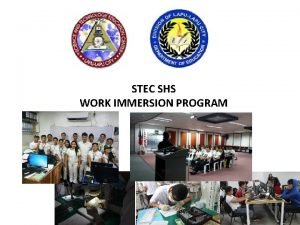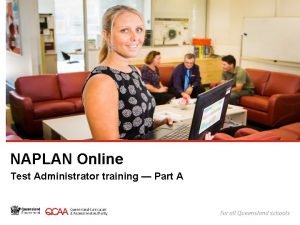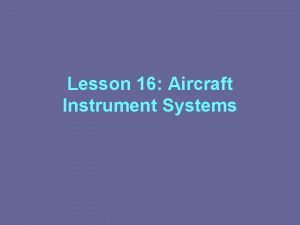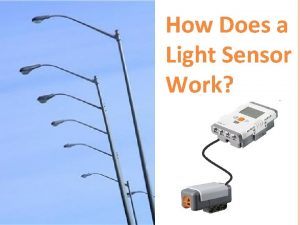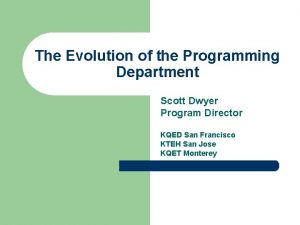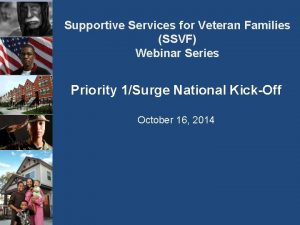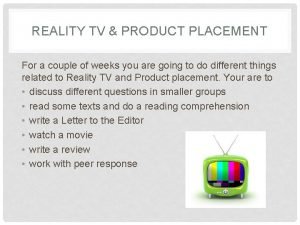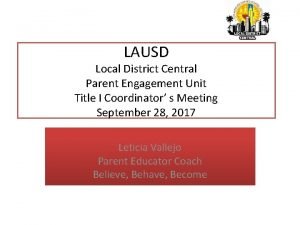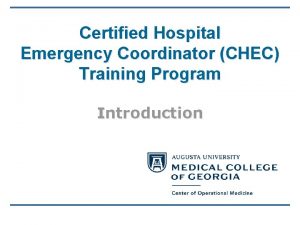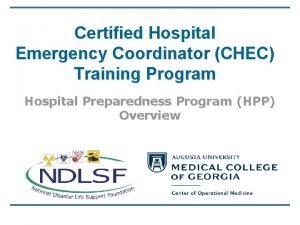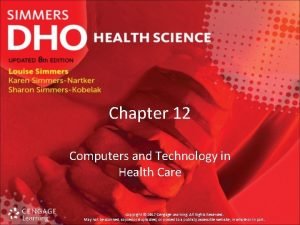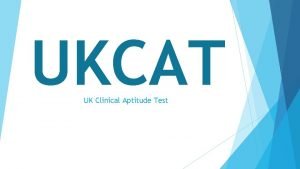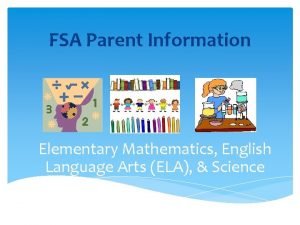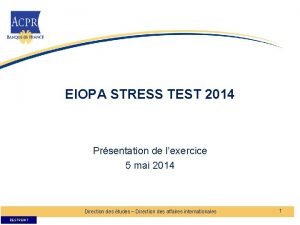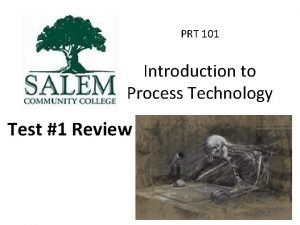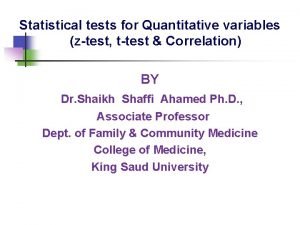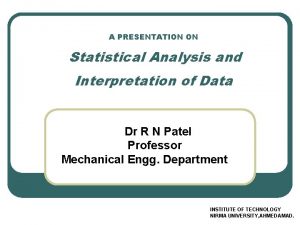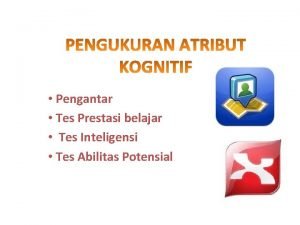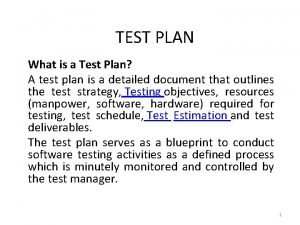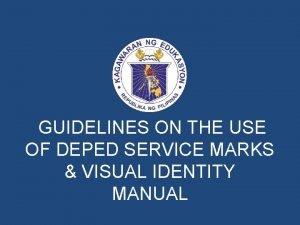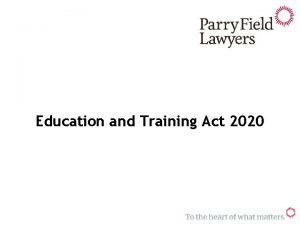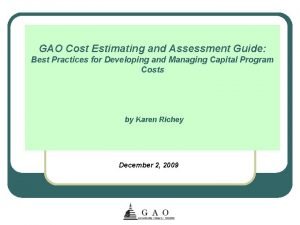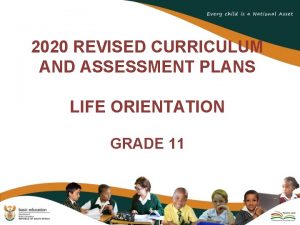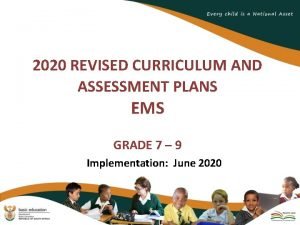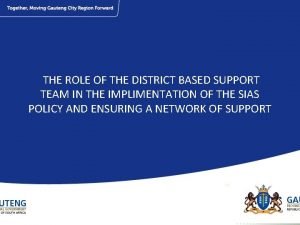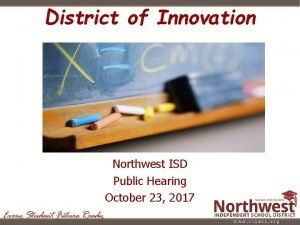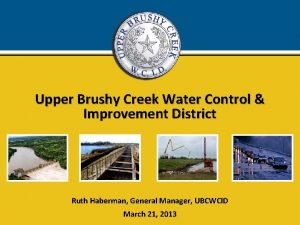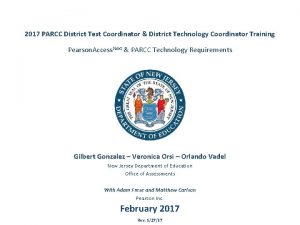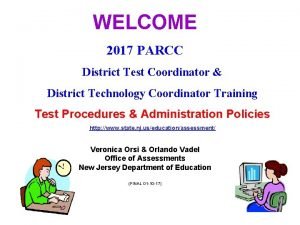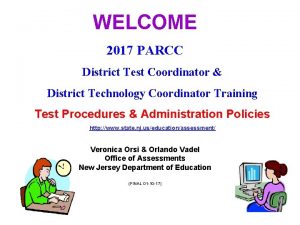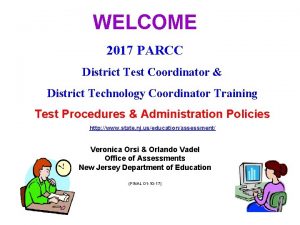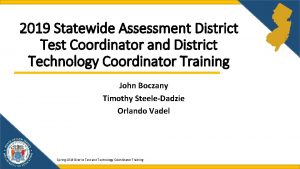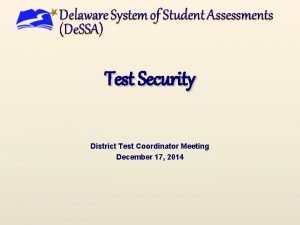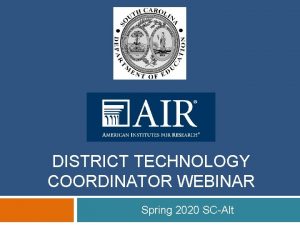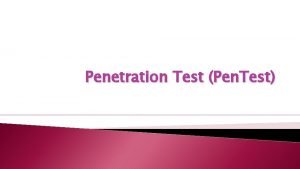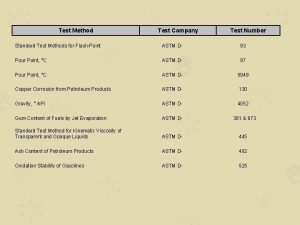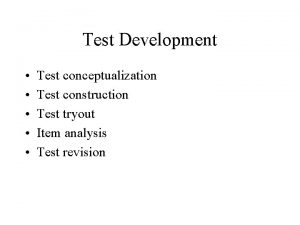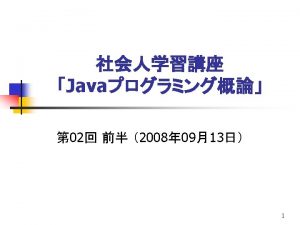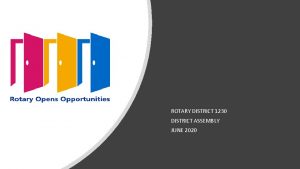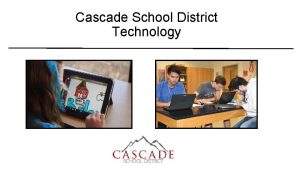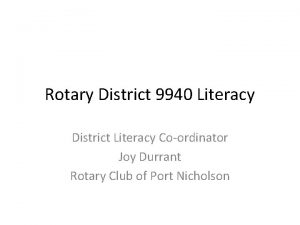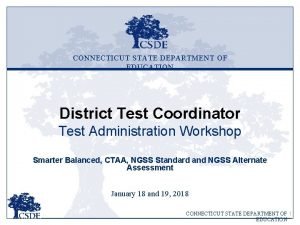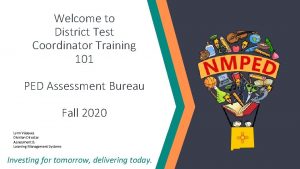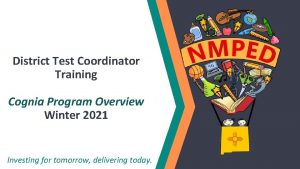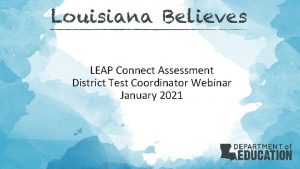2020 District Test Coordinator and District Technology Coordinator












































































































- Slides: 108

2020 District Test Coordinator and District Technology Coordinator Regional Training New Jersey Department of Education Gilbert Gonzalez Timothy Steele-Dadzie Orlando Vadel

Welcome Our Mission: The New Jersey Department of Education (NJDOE) supports schools and districts to ensure New Jersey’s 1. 4 million students have equitable access to high-quality education and that they achieve academic excellence.

Your Contribution and Impact › Turn-key training is a vital component to ensuring that students are supported through the assessment process and data is secure and accurate. › District Test Coordinators are responsible for ensuring that all district and school personnel involved in the administration of New Jersey state assessment programs have been trained. › State Assessment Coordinators are available to support districts in ensuring the statewide assessment program is implemented with fidelity. 3

What Makes State Assessments Different • Security procedures: Rigorous test security protocols ensure an accurate measure of student performance. • Test Development: Development includes several item reviews to ensure equitable access among all student populations. • Data and reporting: Informs federal and state accountability systems, including school and district decisions on curriculum. • State and federal requirements: Participation is required by federal and state law to ensure all students have access to a high-quality education. 4

Informing Improvements: Phase I and II Summary Phase I: May-July 2018 Phase II: January-April 2019 ü 75 conversations around the state and 3 webinars ü 243 practitioners ü 21 counties ü 2, 363 of New Jersey residents ü technology and platform --assessment design --- data and reporting --- implementation --accessibility --- student portfolio appeals ü Over 3, 200 suggestions for improvements ü 151 districts 5

What’s New for Spring 2020 • Updated score interpretation guides • New reporting resources for educators and parents in the New Jersey Student Learning Assessments Resource Center • Parent Portal • Video Score Reports • NJDOE Digital Item Library • Tech Support Office Hours 6

Scheduling Spring 2020 District Test and Technology Coordinator Training 7

Spring 2020 Statewide Assessments Testing Schedule Assessment Grades Computer-Based Testing (CBT) Paper-Based Testing (PBT) Regular Administration (ELA and Math) 3 through 10 4/20/20 to 5/29/20 4/20/20 to 5/1/20 Spring Block (ELA and Math) 9 and 10 4/27/20 to 6/8/20 4/27/20 to 5/8/20 Science 5, 8, and 11 4/20/20 to 5/29/20 4/20/20 to 5/1/20 Summer Administration (ELA and Math) 9 and 10 7/27/20 to 8/7/20 Portfolio Appeals (ELA and Math) 12 N/A 1/6/20 to 5/8/20 Dynamic Learning Maps (DLM) (ELA, Math and Science) 3 to 8, 11 4/1/20 to 5/29/20 N/A 8

Key Spring Dates for 2020 Activity Owner ELA/Math: Starting January 22, 2020 Review and Update Student Registration/Personal Needs Profile (SR/PNP) information in Pearson. Accessnext (PAN) Districts Infrastructure Trial Begins Districts Paper Materials Arrive in District Key Dates NJDOE/Districts Science: December 5 to January 3, 2020 (initial registration) February 3, 2020 ELA/Math: All test materials are expected to arrive in district no later than April 3, 2020 Science: All test materials are expected to arrive between April 7 to 9, 2020 9

Key Spring Dates for 2020, continued For specific activities and dates, please download the Spring 2020 ELA/Math Key dates and the Spring 2020 Science Key dates. Activity Additional Order Window Begins Deadline to Return Secure Scorable Test Materials to Vendor Owner Districts Key Dates ELA/Math: April 6, 2020 Science: April 7 to 27, 2020 Regular Administration: May 8, 2020 Spring Block Administration: May 15, 2020 10

Unit Test Times for ELA: Non-Field Test Schools ELA Unit 1 Unit 2 Total Test Time Grade 3 75 minutes 2 hours 30 minutes Grades 4 to 5 90 minutes 3 hours Grades 6 to 10 90 minutes 3 hours Note: Unit times do not include the recommended 25 to 30 minutes for logging students on, reading directions from the Test Administrator Manual (TAM), and logging students off. 11

Unit Test Times for ELA: Field Test Schools ELA Unit 1 Grade 3 Grades 4 to 5 Unit 2 Unit 3 Total Test Time 75 minutes 3 hours 45 minutes 90 minutes 4 hours 30 minutes Grades 6 to 10 90 minutes 4 hours 30 minutes Note: Unit times do not include the recommended 25 to 30 minutes for logging students on, reading directions from the Test Administrator Manual (TAM), and logging students off. 12

Unit Test Times for Mathematics Unit 1 Unit 2 Unit 3 Total Test Time Grades 3 to 5 60 minutes 3 hours Grades 6 to 8 60 minutes 3 hours Algebra I, Geometry, 90 minutes Algebra II 90 minutes N/A 3 hours Note: Unit times do not include the recommended 25 to 30 minutes for logging students on, reading directions from the Test Administrator Manual (TAM), and logging students off. 13

Unit Test Times for Science Unit 1 Unit 2 Unit 3 Unit 4 Total Test Time Grade 5 45 minutes 3 hours Grade 8 45 minutes 3 hours High School 60 minutes 4 hours Note: Unit times do not include the recommended 25 to 30 minutes for logging students on, reading directions from the Test Administrator Manual (TAM), and logging students off. 14

Scheduling Test Units: Requirements ü Two units max per day per student ü Units within a content area must be administered in sequence (i. e. , Science Unit 1, followed by Unit 2, followed by Unit 3, followed by Unit 4) ü Students with an extended time accommodation, as specified by their Individualized Education Program (IEP), 504 Plan, or English Language Learner (ELL) Plan, should begin testing in the morning and complete a given unit by the end of that school day 15

Scheduling Test Units: Flexibilities ü Testing may be scheduled for any school day during the 30 -day testing window ü Absent students can resume testing with their assigned group and be assigned to make-up sessions for units missed ü No special order is required for administration by grade or content area (math followed by ELA or ELA followed by science, etc. ) ü Back to back units are permitted; students must have a supervised break between units ü Multiple groups of students can be scheduled in a single day (AM Group 1 takes two units; PM Group 2 takes two units, etc. ) ü If necessary, grades may be combined for the same content area if unit test times and read aloud test directions are the same 16

Testing Requirements Spring 2020 District Test and Technology Coordinator Training 17

Testing Requirements: Overview All public schools are required by state and federal law* to test all students in grades 3 to 8 and high school. The following slides outline testing requirements and considerations for specific populations of students. • Elementary school • English Language Learners • Middle school • Students with Disabilities • High school • Adult Education *See requirements in the Every Student Succeeds Act (ESSA) sec. 1111(b) and N. J. A. C. 6 A-8 -4. 1(d) 18

Who Must Test: Elementary and Middle School • All students in grades 3 through 8 are expected to participate in statewide assessments based on their current grade level enrollment, not on the level of instruction received during the academic school year. • The only exception is for middle school students who are taking any of the high school math courses (i. e. , Algebra I, Geometry, Algebra II). These students are expected to take the end of course assessment that matches their mathematics course enrollment. • 5 th, 8 th, and 11 th grade students must participate in the science assessments. • Elementary and middle school students with disabilities, except those with the most significant intellectual disabilities who qualify for the DLM, must participate in statewide assessments. 19

Who Must Test: Middle School Math • Middle school students enrolled in a one-year Algebra I or Geometry course must take the Algebra I or Geometry assessment instead of their grade-level math assessment. • Middle School students enrolled in a two-year Algebra I or Geometry course must take their grade-level math assessment in the first year of the course, then take the Algebra I or Geometry assessment in the second year of the two-year course. • Middle school students enrolled in multiple high school level mathematics courses (Algebra I, Geometry, Algebra II) will take only one math assessment. 20

Who Must Test: High School Math • High school (HS) students in grades 9 and 10 not enrolled in a tested math course will not take a state assessment • If a HS student retakes a course they did not pass in the prior year, but they did pass the assessment, they are not required to take the assessment again • HS students currently enrolled in an Algebra I, Geometry, or Algebra II course must take the corresponding state assessment unless they are repeating the course, but have previously passed the assessment associated with the course • HS students enrolled in multiple math courses will take only one state math assessment per assessment administration. A student should take Algebra I to meet their primary graduation pathway requirement in cases where students are taking Algebra I and Geometry. 21

Who Must Test: High School Math, continued • HS students enrolled in an integrated math course that includes Algebra I or Geometry, and is a prerequisite for an Algebra I or Geometry course, do not take the Algebra I or Geometry assessment while enrolled in the course • These students must wait until they are enrolled in the Algebra I or Geometry course to take the test • HS students enrolled in an integrated math course that includes Algebra I or Geometry, and is an alternative to an Algebra I or Geometry course, must take the Algebra I or Geometry assessment 22

Who Must Test: High School ELA • 9 th and 10 th grade students must take the grade level specific ELA assessment regardless of the ELA course they are currently enrolled in. Exception: Students repeating a course who have previously passed the associated assessment are not required to re-take that assessment. • Students enrolled in multiple ELA courses will take only one ELA assessment, as deemed appropriate by the school district. Exception: If one of the multiple ELA courses is Grade 10 ELA, the students must take the Grade 10 ELA assessment. • Grade-level ELA course/credit assignment determines participation in statewide assessments, not the grade-level homeroom assignment. 23

Who Must Test: High School Science • High school students are required to participate in the statewide science assessment in grade 11. • This requirement is determined by credit total, not homeroom assignment. • Example: A 10 th grade student who has attained enough credits to be considered an 11 th grade student, but has a grade 10 homeroom, would take the science assessment. • Example: An 11 th grade student who has attained enough credits to be considered a 12 th grade student, but has a grade 11 homeroom, would not take the science assessment. 24

Graduation Assessment Requirement Classes of 2020 -2022 Pathway I Demonstrate proficiency in the high school end-of-course state assessments in ELA-10 and Algebra I English Language Arts (ELA) NJSLA/PARCC ELA Grade 10 ≥ 750 (Level 4) Mathematics NJSLA/PARCC Algebra I ≥ 750 (Level 4) 25

Graduation Assessment Requirement Classes of 2020 -2022, part two Pathway II Demonstrate proficiency in ELA and/or mathematics by meeting the designated cut score on one of the alternative assessments. See cut scores for each assessment here. Alternative Assessments: ELA • • • NJSLA/PARCC ELA Grade 9 NJSLA/PARCC ELA Grade 11 SAT Critical Reading (taken before 3/1/16) SAT Evidence-Based Reading and Writing Section SAT Reading Test ACT Reading or ACT PLAN Reading 1 ACT Aspire Reading 1 ACCUPLACER Write. Placer ESL PSAT 10 Reading or PSAT/NMSQT Reading ASVAB-AFQT Alternative Assessments: Math NJSLA/PARCC Geometry NJSLA/PARCC Algebra II SAT Math (taken before 3/1/16) SAT Math Section SAT Math Test ACT or ACT PLAN Math 1 ACT Aspire Math 1 ACCUPLACER Elementary Algebra Next-Generation ACCUPLACER Quantitative Reasoning, Algebra, and Statistics (QAS) • PSAT 10 Math or PSAT/NMSQT Math • ASVAB-AFQT • • • 26

Graduation Assessment Requirement Classes of 2020 -2022, part three Pathway III Demonstrate proficiency in English language arts and/or mathematics through Portfolio Appeals, which includes: • Student transcripts and the district intervention plan for student • Performance on state and alternate competency assessments • Constructed-Response Tasks or CRTs in the subject areas in which the student is deficient (ELA and/or math) • CRTs are designed, administered, and graded locally according to state assessment evidence statements • CRTs must be designed for students to demonstrate competency in state standards (in ELA and/or math) • Additional general information as needed • The Portfolio Appeals Process is available to students at the beginning of their 12 th grade year. 27

Who Must Test: ELLs • All English Language Learners must take the New Jersey state assessments. • Students who are newly arrived English Language Learners (ELLs) must take the math and science assessments. Newly arrived ELLs in grades 3 through 10 are exempt the ELA state assessment for their first school year. • • Note: students are considered newly arrived if they enter the country after July 1 of the prior academic year. ELLs from Puerto Rico are eligible for this exemption. ELLs enrolled in English as a Second Language (ESL) (beginner, intermediate, or advanced level) must take the ELA assessment associated with their course equivalent/credit assignment, not the level of the ESL course. 28

Who Must Test: Special Education Students with disabilities, except those with the most significant intellectual disabilities who qualify for the Dynamic Learning Maps (DLM) assessment, are required to take state assessments. Students with IEPs that are exempt from passing: ü Are required to take all appropriate statewide assessments only once ü Are not required to pass statewide assessments, alternate graduation assessments, or participate in the portfolio appeals process 29

Alternate Assessment Eligibility-DLM • Only those students who have a significant intellectual disability should be taking the DLM assessments. This subgroup of students is approximately one percent of students with disabilities. • The vast majority of students with disabilities will take the NJSLA assessments with appropriate accommodations. The IEP team will determine which of the NJSLA accommodations the student will receive and document this in the IEP. • Under ESSA, only one percent of students can take the alternate assessment (DLM). • Anticipated performance on the general education assessment or behavior concerns during testing are not valid reasons for having a student participate in the alternate assessment. • • Review the updated DLM Participation Guidelines for further information. English Language Learners who take the DLM are eligible to take the Alternate-ACCESS. • Review the Alternate-ACCESS Participation Criteria for further information. 30

Alternate Assessment Eligibility-DLM, continued • Districts who anticipate more than one percent of students taking the DLM assessment can request a waiver. • Review of waiver requests from previous years demonstrated that some districts have more than five percent of students taking the alternate assessment. • ESSA requires the NJDOE to conduct activities in districts that exceed the one percent cap. This could consist of file review, interviews and technical assistance. 31

Who Must Test: Adult High School Students • Adult high school students enrolled in a currently assessed course (Algebra I, Geometry, Algebra II) are not required to take the associated statewide assessment. • Adult high school students who passed any historical statewide assessment (HSPT, HSPA, etc. ) will have their passing scores banked and counted toward their graduation testing requirement. These students will not take the current state assessments. • Adult high school students who took, but did not pass, any historical statewide assessments must meet the graduation assessment requirement via the alternative pathways or the portfolio appeal process. Note: Students who did not pass a historical statewide assessment in any one content area (ELA or math) must rely on the alternative pathways or portfolio appeals process to meet the graduation assessment requirements for that content area. 32

Homebound Students, Bedside Instruction, and Non-Testing Out-of-District Placements • Homebound students, or those receiving bedside instruction, must be tested unless they meet the definition of medical emergency. • A medical emergency is defined as the occurrence of a severe medical or psychiatric condition or episode that requires medical attention or supervision, during which time a student is unable to participate in statewide assessments. • These students, as well as students in a situation where an Out-of-District placement does not administer state assessments, may be administered the paper- or computerbased assessment by having the accountable school send a Test Administrator to the student’s location. • • Students should be tested during the hours they normally receive instruction. Any accommodation(s) specified for state assessments should be in alignment with those routinely used by students during classroom instruction and locallyadministered assessments. 33

Homebound Students, Bedside Instruction, and Non-Testing Out-of -District Placements Test Administrator Qualifications and Requirements ü Licensed professional employed by the district ü Trained by the district or school test coordinator ü Signs appropriate chain of custody forms and test security agreement ü Maintains test security at all times ü Has access to technology coordinator and test coordinator for support and guidance ü Returns all secure testing materials to school test coordinator or district test coordinator as soon as possible after testing is completed ü Guidance for administering assessments to homebound, bedside, and non-testing Out-of. District placement students can be found on the NJDOE assessment district guidance page. 34

Testing Site Requirements, continued ü Students must be well spaced with ample surface area ü Provide assigned seating ü Provide good lighting and ventilation ü Use clock and chart to display time remaining ü Never leave students unattended ü Always supervise students including during restroom breaks ü Hallways should be monitored to keep testing rooms undisturbed ü Post “Testing Do Not Disturb” signs on testing room doors 35

Testing Site Requirements The following behaviors and materials are not permitted in testing rooms: • Coats, backpacks, or purses • Instructional displays • Buzzers, bells, or non-emergency announcements or interruptions during testing • Cell phones, MP 3 players, or any unauthorized electronics • Food or beverages (except if permitted by IEP or 504) • Note: this list is not exhaustive 36

Accessibility Features and Accommodations Spring 2020 District Test and Technology Coordinator Training 37

Accessibility Features: Overview • The purpose of administrative considerations, accessibility features, and accommodations is to remove barriers to accessing the assessment content for all participating students. • These features do not provide advantages to student performance; they enable students with specific needs to access the assessment content to demonstrate their proficiency. • Some features are readily available for student use, and some must be identified in advance and enabled in a student's SR/PNP data file. • Use student data and set planning meetings with teachers and special education support staff to ensure students receive the supports they need. 38

Accessibility Features and Accommodations, continued Administrative Considerations for All Students Accessibility Features for all Students (Including Identified in Advance) Accommodation s for Students with Disabilities, 504, ELL Only 39

Administrative Considerations for All Students ü Small Group Testing ü Time of Day ü Separate or Alternate Location ü Specified Area or Setting ü Adaptive and Specialized Equipment or Furniture ü Frequent Breaks 40

Accessibility Features for All Students • Answer Masking* • Line Reader Mask Tool • Audio Amplification • Magnification/Enlargement Device • Bookmark • Notepad • Color Contrast* • Pop-up Glossary • Blank Scratch Paper • Redirect Students to the Test • Eliminate Answer Choices • Spell Check or External Spell Check Device • General Administration Directions Clarified • General Administration Directions Read Aloud and Repeated as Needed • Student reads Assessment Aloud to Self* • Text-to-Speech for Mathematics/Science* • Highlight Tool • Human Reader/Human Signer for Mathematics/Science* • Headphones or Noise Buffers • Writing Tool * = must be identified in advance 41

Accommodations for Students with Disabilities • • • IEP or Section 504 Plan teams are responsible for making all accommodation decisions. Accommodations must be documented in an approved IEP or Section 504 Plan. Students should have prior experience using the accommodation routinely during classroom instruction and on locally-administered assessments. 42

Presentation Accommodations for Students with Disabilities • Assistive Technology • Closed Captioning of Multimedia on ELA • Screen Reader Version • American Sign Language (ASL) Video for Mathematics/Science • Refreshable Braille Display with Screen Reader Version for ELA • Hard Copy Braille Edition (provided in Unified English Braille) • Tactile Graphics • Large Print Edition (provided in 18 -point font on paper sized 14”x 18”) • Paper-Based Edition (must have a valid IEP or Section 504 Plan) • Human Signer for Test Directions • ELA Assessments, including items, response options, and passages • Text-to-Speech • American Sign Language (ASL) Video • Human Reader/Human Signer 43

Response Accommodations for Students with Disabilities • Assistive Technology (Non-Screen Reader) • Assistive Technology Device • Braille Note-taker • Monitor Test Response • Braille Writer • Word Prediction External Device • Calculation Device (on Calculator Section of Mathematics Assessment) • Calculation Device and Mathematics Tools (on Non-Calculator Sections of Mathematics Assessment) • ELA Selected Response Options, ELA Constructed Response Options and Math/Science Response Options • Speech-to-Text • Human Scribe • Human Signer 44

Speech-to-Text Guidance If the product is used routinely by the student during classroom instruction, students receiving Speech-to-Text as an accommodation may use a third-party web -based product that requires the use of the internet to initiate the product. ü Student must test one-to-one (i. e. , test administrator and student). ü Test Administrator must monitor the student. ü Technology Coordinator must verify third-party device was not used to access the internet outside of its original purpose. 45

Text-to-Speech Guidance The text-to-speech feature needs to be turned on for each student in their SR/PNP. Considerations should be made during assignment, as these supports must mirror what supports students receive during their regular classroom instruction. • For ELA, text-to-speech is an accommodation. Students must have a valid IEP or 504 plan to access this feature. • For math and science, text-to-speech is an accessibility feature. IEPs and 504 Plans are not necessary to use this feature for math and science; however, it should not be administered to all students simply because it is available. • Students using text-to-speech should be familiar with the functionality of the tool prior to using it on a state assessment. 46

Extended Time (must have a valid IEP or Section 504 Plan) Timing and Scheduling Accommodation for Students with Disabilities ü Students have until the end of the school day to complete a single test unit administered during the prescribed testing window. ü Students receiving this testing accommodation should be tested in a separate setting to minimize distractions to other students, and to schedule for testing in the morning to allow adequate time to complete a test unit. 47

Accommodations for English Language Learners (ELLs) ü ELL teams are responsible for making all accommodation decisions. ü Accommodations for ELLs must be documented in the student’s ELL Plan. ü Students should have prior experience using the accommodation routinely during classroom instruction and locally-administered assessments. ü Newly arrived ELLs, in grades 3 through 10, who are enrolled in United States schools after June 1 of the prior school year, may be excluded from taking the ELA assessment in the current school year. ü Students classified as ELLs whose parent/legal guardian has refused language support services are eligible to receive ELL testing accommodations as deemed appropriate. 48

Accommodations for ELLs ü ü ü Online Transadaptation of the Mathematics/Science Assessment in Word-to-Word Dictionary (English/Native Spanish Language) ü Paper-Based Edition of Mathematics/Science Response Speech-to Mathematics/Science Assessment in -Text or Human Scribe Spanish General Administration Directions Read ü Large Print Edition of the Aloud and Repeated in Student’s Native Mathematics/Science Assessment in Language* Spanish General Administration Directions ü Text-to-Speech or Human Reader for the Clarified as Needed in Student’s Native Mathematics/Science Assessment in Language Spanish Extended Time Note: Read aloud directions are available in the following languages: Arabic, Bengali, Chinese Mandarin, Gujarati, Haitian Creole, Korean, Portuguese, Russian, Spanish, Urdu. Science translation available in Spanish only. 49

Test Security and Information Security Spring 2020 District Test and Technology Coordinator Training 50

Information Security Overview • In addition to test security, districts are responsible for ensuring that student information, including Personally Identifiable Information (PII), remains secure. • Districts are responsible for controlling who has access to the statewide assessment administration platforms. • Districts must establish a process within their District Security Plans for managing user permissions and access, including disabling unnecessary user accounts. 51

Information Security: Account Management • Districts are responsible for controlling who has access to Pearson. Access next (PAN) and at what level • User accounts must be reviewed regularly to ensure that those who need access have it and those who do not need access do not • Inactive accounts are automatically set to expire annually on December 31 of each year • Districts should regularly review the PAN User Role Matrix to ensure that permissions are assigned correctly 52

Information Security: Personally Identifiable Information (PII) • PII is defined as information that can be used to distinguish or trace an individual’s identity either directly or indirectly through linkages with other information • Examples of PII include a combination of a student’s first name, last name, date of birth, gender, or race • When communicating with the Office of Assessments, only the PAN session name and the last four digits of a student’s State Identification Number (SID) should be provided • Data files and screenshots containing PII should never be transmitted to the Office of Assessments via email • When additional student information is required, a Statewide Assessment Coordinator will arrange for communicating such information via secure methods 53

Information Security: Handling Student Information • Security forms that are required to be transmitted to the Office of Assessments must be uploaded directly to PAN. If you need to send sensitive information via email, contact an Assessment Coordinator to establish encrypted communications. When sending this request, do not include PII until the Assessment Coordinator has responded with further instructions. • Once the form is uploaded, email the support request confirmation number (provided upon successful upload) to the appropriate grade-level NJSLA state coordinator. Include the name of the form, CDS Code, and school and district names in the subject line. 54

Test Security Overview • Test security is a critical component of New Jersey’s Statewide Assessment Program. • The security protocols outlined in this presentation, and in the District Test Coordinator and Test Administrator manuals are intended ensure that students have a fair and standardized opportunity to demonstrate their proficiency on statewide assessments. • Districts are required to incorporate the security protocols outlined in this training into their own district security plans and provide security training all staff members who will participate in the administration of statewide assessments. • The implementation of these security protocols by your school district is mandatory and will support our efforts to deliver a high-quality assessment and experience for all students. 55

Test Security • Security is a district responsibility per N. J. A. C. 6 A: 8 -4. 1 (e) • Reproduction or transmittal of test items, passages, or other secure items or materials is prohibited. • All district and school personnel must be informed of security procedures prior to test administration. • Please refer to Section 2. 0 of the Test Coordinator Manual for ELA/Math and Science for more information. • Note: Security breaches may have professional consequences for staff and disciplinary consequences for students. 56

District Security Plan ü ü ü Mandatory turnkey training Management of user permissions and access Locked storage of secure testing materials Delivery problems Technology problems Missing secure testing materials ü ü ü Reporting breaches and testing irregularities Damaged or contaminated testing materials Incident response chain of command Disruptive or sick students Fire or emergency procedures Inclement weather 57

Training Staff ü Turnkey Training by the District Test Coordinator (DTC) is required for all staff involved in testing ü Districts are strongly encouraged to hold a special training for accommodated testing (i. e. , Scribes, Small Group Testing, One on One, English Learners or ELLs, etc. ) ü Responsibilities of School Test Coordinator (STC), Technology Coordinator (TC), Test Administrators (TA) and Proctors must be clearly delineated ü Only Test Administrators may handle secure test materials ü Proctors (one per 25 students) can handle non-secure materials only ü All staff involved in testing must sign the Security Agreement ü See training guidelines on the New Jersey Student Learning Assessment Resource Center. 58

Test Security Requirements: Unauthorized Electronic Devices • Have a written policy for unauthorized devices are not permitted in any testing room any time before, during, or after testing- no exceptions • Include district approved sanctions for violations and parental notification procedures • Notify parents, students, and staff of device ban policy and district-approved sanctions well in advance of testing • Include procedures for handling cell phones and other devices each day prior to testing, in accordance with your district policies • Include procedures to have all violations immediately reported up the chain of command • Contact appropriate grade level New Jersey Student Learning Assessment (NJSLA) state coordinator immediately 59

Test Security: Computer-Based Testing • All computers and other testing devices must have: ü required software to support computer-based testing ü access to secure internet connectivity • A Chain of Custody form must be used to track distribution and collection of student testing tickets • Return student testing tickets to the School Test Coordinator (STC) immediately after testing is completed for the day • Ensure that mobile testing devices are charged after students complete testing and ready to use for the next testing session 60

Test Security: Paper-Based Testing • Test Booklets must always be stored in a secure location when not in use • Test Booklets may never be accessible to personnel not responsible for testing • Each school must have a designated secure location with locked and restricted access to store secure test materials • Test Coordinators and Test Administrators must use all provided security forms to document test booklet distribution and test booklet return 61

Security Forms • The following forms can be found on the NJDOE Assessment Homepage: Student Personal Needs Profile (PNP) Form • The following forms can be found on the New Jersey Student Learning Assessments Resource Center: • Chain of Custody • Testing Irregularity and Security Breach • Report Contaminated, Damaged, or Missing Materials • Post Test Certification • District Receipt and District Returns for Paper-Based Tests 62

Security Forms – Handling Protocol • The following forms must stay in district: • Security Agreements • Chain-of-Custody forms for Accommodated Tests • Chain-of-Custody forms for Computer Based Tests • District Receipt/Return Form for Testing Materials • File copy of any form(s) emailed to NJDOE or uploaded to PAN • The following forms must be uploaded to PAN: • Irregularity Reports documenting routine refusals, minor irregularities or security breaches • Form to Report Contaminated, Damaged, or Missing Materials • Post Test Certification Form • Note: Do not fax or email forms that contain student PII. Directions on how to upload forms to PAN can be found on the Pearson assessment support site. 63

Security Agreement Upon completion of annual mandatory district turn-key training, the following staff involved in state testing must sign a new Security Agreement to document that they have been sufficiently trained. ü ü ü District Test Coordinators School Test Coordinators District Technology Coordinators (including those contracted to provide technology services) School Technology Coordinators (including those contracted to provide technology services) Test Administrators Proctors Note: Schools must maintain the original signed versions of the Security Agreements for three years. Download the Security Agreement form at the New Jersey Student Learning Assessments Resource Center. 64

Reporting Testing Irregularities and Security Breaches Contaminated, Missing, and Damaged Materials ü STC must report any incident to the DTC immediately ü DTC must then email the appropriate NJSLA state coordinator as soon as possible after receiving notice from the STC ü STC must complete appropriate form documenting the incident and provide completed form to DTC ü DTC must upload form to PAN within five school days and provide NJDOE with support request confirmation number. Be sure to upload to appropriate assessment administration scope within PAN (ELA/Math or Science) 65

Not-Tested Codes and Void Codes • Not-Tested Codes are to be used when a student has never logged into Test. Nav • Absent • Medical emergency • Other (refusal) • Void Codes are to be used when a student has logged into Test. Nav but did not complete testing • Student Cheating • Security Breach • Other (refusal, wrong form, off-grade level, off-course, accommodation/ accessibility feature provided or not provided in error) • A student who starts a test but does not complete it due to being absent for make-up testing cannot be voided. The student’s test must be submitted by marking it complete. 66

Data Clean-Up • It is the responsibility of both the accountable and testing districts and schools to ensure student accountability is accurately reflected in PAN before, during, and after testing • Data clean-up, including the application of Not Tested and Void Codes, should begin as soon as testing is completed and should include a review of the CDS codes that were submitted via the SR/PNP file upload for student accountability • Accountable districts should verify student accountability by running the operational report titled “(For Responsible Organization) Students where Responsible District/School is different from Testing District/School” • Testing districts and schools should verify student accountability by running the operational report titled “Students where Responsible District/School is different from Testing District/School” 67

Data Clean-Up, continued • Update incorrect student accountability records identified after running the reports via the PAN user interface, SR/PNP file upload (before testing), or Student Test Update file (after testing) • For paper-based testing: once test booklets and answer folders have been returned for scanning and processing, Not-Tested and/or Void Codes may be applied • All data clean-up must be completed by June 10, 2020. 68

Student Registration and Accountability Spring 2020 District Test and Technology Coordinator Training 69

Student Registration Overview • The submission of accurate Student Registration/Personal Needs Profile (SR/PNP) data plays a crucial role in ensuring that: • students have the correct assessments • students have the accessibility features and accommodations that they need • district and school assessment data is reflected accurately for reporting and accountability purposes • Student registration information is uploaded to PAN in two ways: • Participation in the NJ SMART State Assessment Registration Submission (SARS) • Direct upload directly into PAN • Note: this is available for ELA/Math after SARS window; student registration data for science is not included in the SARS submission and must be uploaded directly to PAN) • Additional guidance regarding the SR/PNP upload process will be provided in the second half of the presentation 70

Student Registration/Personal Needs Profile, part 1 • Districts submitted initial student registration data through NJ SMART in the late fall of 2019 and NJDOE uploaded data to PAN in early 2020. • Districts review and update the SR/PNP data in PAN and manage test sessions. • SR/PNP data can be updated up until a test starts, but test session preparation must be repeated if changes are made to the test(s) assigned to students. • Science SR/PNP must be uploaded directly to PAN – not through NJ SMART. o The testing site must upload an SR/PNP file, including the correct accountable district and school codes, for each student they are testing. o Science SR/PNP data file must be uploaded under the science administration in PAN. 71

Student Registration/Personal Needs Profile, part 2 Reminders: • Ensure that natural progressions (changes from middle to high school or vocational/technical school, and from K to 8 school to a regional high school) are accurately reflected in student information systems when determining students’ accountable schools and districts when preparing SR/PNP files. • Ensure that the accountable school and testing school codes for students attending In-District and Out-of-District Placements are accurate to avoid incorrect district and school accountability. 72

Student Registration/Personal Needs Profile, part 3 In-District Placement (formerly Out-of-Resident Placement) Sending and Receiving: An in-district placement is established when, due to program services offered, a student attends a school other than the one, they would have attended, in their respective district (English Learner or special education program, etc. ) Code Type Description State Assessment Testing Site District code and State Assessment Accountable District code Same six-digit code (County and District) State Assessment Testing Site School code Three-digit code of the school that is testing the student State Assessment Accountable School code Three-digit code of the school the student would normally attend if the school could provide their educational services/programs 73

Student Registration/Personal Needs Profile, part 4 Out-of-District Placement Sending and Receiving: The student attends an out-of-district placement facility for programs/services not offered in their district (i. e. , approved private, public receiving, or special services commission). Approved Private Schools for Students with Disabilities cannot be accountable schools or districts. Code Type State Assessment Testing Site District Code State Assessment Testing Site School Code State Assessment Accountable District Code State Assessment Accountable School Code Description Six-digit code of the county and district that is testing the student. Three-digit code of the school that is testing the student. Six-digit code of the county and district the student resides. Three-digit code of the school the student would normally attend if the school could provide their educational services/programs. 74

Student Registration/Personal Needs Profile, part 5 • School Choice is not an Out-of-District Placement. • NJDOE’s Inter-District Public School Choice Program allows approved choice districts to enroll students who do not reside within their districts without cost to their parents. • Districts that accept students under “School Choice” must identify themselves as the accountable district and school. • For additional information refer to NJSMART Reporting Responsibilities 75

Student Registration/Personal Needs Profile, part 6 • Students attending a charter school or full-time vocational technical school, regardless of the school’s location, are not considered Out-of-District or In-District Placements. • Charter schools and full-time vocational technical schools are the accountable district and school. • The resident school district is accountable for shared-time vocational technical students • For additional information refer to NJ SMART Reporting Responsibilities 76

Transferring Student Records • The Inter-District Transfer “Work Request” Process is a tool in PAN that allows authorized users to transfer student assessment data between districts to manage student transfers. • The DTC of the new district will use this feature to request the transfer, and the DTC of the former district will use this feature to approve the transfer request • If a new student enters your district after initial SR/PNP upload, please refer to page 2 of the Transfer Student CBT Guidance document • If a student leaves your district after initial SR/PNP upload, please refer to page 9 of the Transfer Student CBT Guidance document • If a student leaves your district before testing begins, you should unregister, unassign all tests, and unenroll the student from your organization • Do not request a Work Transfer for any student who has completed all testing in their previous district and has moved into your district 77

Materials and Tools Spring 2020 District Test and Technology Coordinator Training 78

Initial Materials Shipment: District Box ü Paper bands (one per 20 students) ü Color coded Pearson/Measurement Incorporated Scorable and Non. Scorable Return Labels (one each per 25 students) ü UPS Ground Return Labels (Pearson – ELA/Math) OR Fed. Ex Return Labels (MI – Science) (one per 25 students) ü Return instructions sheet ü Shipping carrier return instructions Pro Tip: Save your box for returns 79

Initial Materials Shipment: School Box ü Pre-Printed/Pre-Gridded Used Test Booklets/Return School Headers (one per grade/subject testing) ü Student ID labels and roster ü Packing List and Chain of Custody forms ü Test Coordinator Manuals (one per school) ü Test Administrator Manuals (one per 25 students) ü Student Test Kits ü Large Print Kits, Braille Kits, Spanish Kits, Read Aloud Kits ü Tactile Graphics, Human Reader Scripts Pro Tip: Save your box for returns 80

Auditing Test Materials Upon receipt of test materials, DTC must: 1. Remove the packing list, Chain of Custody form and Test Coordinator Kit from Box 1 2. Inventory materials immediately to verify that all materials have been included and are not damaged or missing 3. Count each secure paper-based test kit without opening it - Do not open shrink wrapping until two school days before testing 4. Secure materials in locked storage with limited access 5. Order additional materials, if necessary 6. Keep the shipping boxes to return Scorable and Non-Scorable materials to Pearson (Math/ELA) or Measurement Incorporated (NJSLA-Science) after testing is completed - You must ensure that these shipments are sent to the appropriate vendor 7. Report any contaminated, damaged, or missing materials using the District Return Form. Also, please contact the NJSLA support helpline immediately regarding any missing/damaged materials: 888 -705 -9416 (follow phone prompts). 81

Auditing Test Materials, continued • Only users with the DTC roles can order additional test materials. • Do not submit additional orders prior to verifying initial shipment of test materials. • Please allow three to five business days to receive materials after NJDOE reviews and approves the additional order. • All orders are shipped to your district’s central office. 82

Test Materials, part 1 • Paper-Based Test materials • Complete individual sets consisting of test booklet, answer folder, Mathematic Reference Sheet, and/or Periodic Table • Consumable Test Booklet for grade 3 only • Student Pre-ID labels • Computer-Based Test materials • Student Testing Tickets 83

Test Materials, part 2 • Headphones or ear buds • Required for ELA for all students • Required for mathematics/science if student is receiving Text-to-Speech • Headphones may be used as noise buffers (accessibility feature) • Headsets with microphones must used by students who will use Text-to-Speech testing accommodation • Other Materials • Blank Scratch Paper – graph, lined, or unlined paper • Pencils – wooden No. 2 with erasers • Periodic Table for science • More information on calculators and math tools is on the New Jersey Student Learning Assessments Resource Center 84

Test Materials, part 3 • Approved external devices may not access the internet nor store/save information unless authorized by NJDOE • Use of Web-based Third Party Assistive Technology guidance (PDF) • Timing device • Flip chart or board • Door sign – see Appendix C in the TAM • Leisure reading materials 85

Calculators: Preparation • Calculators are permitted only on the “Calculator Section” of math units. • Computer-Based Testing (CBT) • A calculator is automatically provided within the Test. Nav platform during Calculator Sections. • Students must have prior experience with the Test. Nav-provided calculator. Practice tests and tutorials are available via the NJSLA resource center. • Handheld calculators must be used for PBT. • All handheld calculators must meet grade/course specific calculator requirements. • For science testing, the grade-appropriate calculator is permitted on all units. 86

Calculators: Preparation, continued • Handheld calculators must be distributed and collected as specified in the TAM • Districts may provide CBT students with appropriate handheld calculators as necessary • Students may use their own calculator, provided it meets all calculator policy requirements • Examiners must have extra calculators available if handheld calculators are required by a student’s IEP or 504 Plan • Remove instructional manuals and function reference sheets of handheld calculators before testing • Memories and programs of all handheld calculators must be cleared before and after testing 87

Calculators: Specifications by Grade • For Grades 3 through 5 mathematics students: • Students may not use calculators unless the have an IEP or 504 calculator accommodation • Students with a calculator accommodation will use a four-function calculator • Grade 5 science students will utilize a four-function calculator • Grades 6 and 7 mathematics students will utilize a four-function calculator with square root and percentage functions • Grade 8 mathematics/science students will utilize a scientific calculator • Students taking Algebra I, Geometry, Algebra II, and grade 11 science will utilize a graphing calculator • Only IEP/504 students are permitted to use a lower-level version of their specified calculator • These students must be provided with both the grade/course specified calculator (handheld or Test. Nav), and an additional handheld lower-level calculator 88

Calculators: Restrictions The following are not permitted for use during math or science testing: • Calculator apps on a computing device (tablet, smartphone, etc. ) • Calculators with QWERTY keyboards • Calculators with built-in Computer Algebra Systems (CAS) • The sharing of calculators by students 89

Mathematics Reference Sheets • Mathematics Reference Sheets are based on the state’s standards for mathematics. • Mathematics Reference Sheets are required for grade 5 -8, Algebra I, Geometry, and Algebra II. • For online test takers, the Mathematics Reference Sheets are provided online in Test. Nav • Mathematics Reference Sheets are available to be printed on the New Jersey Student Learning Assessments Resource Center 90

Periodic Table • A Periodic Table is available in Test. Nav for students taking computer-based assessments • Printed Periodic Tables will be shipped with paper-based test materials • The Periodic Table is also available to download and print from the Measurement Inc. support site in English and Spanish. 91

Mathematics Tools • Geometry tools such as tracing paper, reflection tools, straight edge, and compass are optional and may be provided by districts for the grade 8 mathematics and Geometry assessments. • Hard copy rulers and protractors for certain grade-level paper-based assessments are provided • For computer-based testing, the required tools are provided through the Test. Nav platform • Rulers and Protractors for Paper-Based Testing: Grade/Course NJSLA Provided Allowable (Not Provided) Grade 3 Ruler (1/4 inch) None Grades 4 to 7 Ruler (1/8 inch) & Protractor None Grade 8 Ruler (1/8 inch) Protractor Algebra I, Geometry, Algebra II None Ruler & Protractor 92

Paper-Based Testing Materials and Procedures Spring 2020 District Test and Technology Coordinator Training 93

Initial Materials Shipment • Secure PBT materials will now be shipped in individual kits instead of packages of test booklets and answer documents • Accommodated test materials will arrive in pre -packaged shipments based on the data submitted in the Student Registration/Personal Needs Profile upload. • All test materials will be delivered directly to central office • Pro Tip: Save your box for returns 94

Preparing Secure Test Materials For Return • DTC receives materials from STC. • Scorable Test Booklets or Answer Folders must include a Student ID Label or hand-gridded student demographic data. • Large Print and Braille responses must be transcribed into answer documents. • Complete School Header Sheet for each grade level and subject. • For ELA and math, scorable and non-scorable materials must be packaged separately in the boxes in which they were delivered – do not overfill. • For science, use the provided Fed. Ex Packs for answer documents – do not overfill. • Place one return shipping label on the top of each box. • Sequence of boxes is indicated on each return shipping label. 95

Preparing Secure Test Materials For Return, continued • Pickups must be scheduled at least 24 hours in advance and no later than one week after the completion of testing • Contact UPS at 1 -800 -823 -7459 to schedule pickup of ELA and math test materials for return to Pearson • Contact Fed. Ex at 1 -800 -Go. Fed. Ex (1 -800 -463 -3339) to schedule pickup of science test materials for return to Measurement Incorporated • Tell UPS or Fed. Ex you are calling about a pickup request using Pearson or Measurement Incorporated’s return service (as applicable) • • UPS and Fed. Ex customer service is available 24/7 Once pickup is confirmed, keep a record of the confirmation numbers you receive from UPS or Fed. Ex 96

Scorable Secure Test Materials to be returned (ELA/Math) • Used by student – grade 3 test booklets • Transcribed by scribe – grade 3 test booklets • Used by student – grade 4 to 10 answer documents • Transcribed by scribe – grade 4 to 10 answer documents Reminders: ü All responses from Large Print and Braille forms must be transcribed by staff into regular version answer document. ü Districts are required to follow the directions for transcribing student test responses found in Appendix C of the AFA Manual. 97

Packaging Scorable ELA/Math Secure Test Materials to Return • By May 8, 2020: Districts must order all scorable return shipment materials (shipping labels, boxes, etc. ) • After May 8, 2020: Districts who order scorable return shipment materials are required to expedite their shipment to arrive to the vendor no later than May 15, 2020 • After May 15, 2020: Any district that fails to return scorable return materials to the vendor by the May 15 will be responsible for late scoring fees; $500 per student, per content area 98

Packaging Non -Scorable ELA/Math Secure Test Materials • Place a single non-scorable materials return shipping label on top of each box • Count the total number of non-scorable boxes • On the line that reads “BOX _ OF _” fill in the sequence of non-scorable boxes being returned • Do not write anything else on the labels • Do not include your nonscorable box count with your scorable box count • Refer to the TCM for science procedures, which differ marginally 99

Packaging Secure NJSLA-Science Test Materials for Return to Measurement Incorporated • Package Scorable and Non-scorable Secure Test Materials in separate boxes • If you are a DTC with more than one school, you do not need to use separate boxes for each school • Place one scorable or nonscorable return label on the side of each box • On the line that reads “BOX _ OF _” fill in the sequence of boxes being returned • Do not write anything else on the labels • All materials are returned together to a single location and all boxes should be numbered 1 through XX sequentially and returned in a single shipment • • Begin your numbering with the boxes that contain scorable test materials. Place one Fed. Ex Return Shipping label on the top of each box, covering the previous shipping label (May also remove or mark out the previous shipping label) 100

Sample Materials Return Shipping Label 101

Sample Test Materials Return Shipping Labels for NJSLAScience Fed. Ex to Measurement Incorporated 102

Important Links and Contact Information 103

Important Links • NJSLA-ELA and Math Information & Practice Tests: https: //nj. mypearsonsupport. com/ • NJSLA-Science Information & Practice Tests: www. measinc. com/nj/science • Pearson. Accessnext : https: //nj. pearsonaccessnext. com • Pearson. Accessnext Training: https: //trng-nj. pearsonaccessnext. com • Technology Setup: https: //nj. mypearsonsupport. com/ • Download Test. Nav: https: //download. testnav. com/ • Security Forms: https: //nj. mypearsonsupport. com/manuals/#forms 104

NJDOE Contact Information Topic Email Phone Grades 3 to 8 Orlando. Vadel@doe. nj. gov 609 -376 -3470 High School Timothy. Steele. Dadzie@doe. nj. gov 609 -376 -3469 General Inquiries assessment@doe. nj. gov 609 -376 -3960 When contacting the appropriate grade-level coordinator: • Please include your name and phone number, along with extension • Do not include the student’s personally identifiable information (PII) - Only provide the student’s State Identification Number (SID) • Do not send the same email to multiple coordinators 105

Additional NJDOE Contacts • Annual Progress Targets, Student Accountability and School Performance Reports • Office of Performance Management • Phone Number: 609 -376 -3509 • reportcard@doe. nj. gov • ELLs, Bilingual Education, ACCESS, and Mc. Kinney-Vento Support • Office of Supplemental Education Programs • Phone Number: 609 -376 -9080 • ELL@doe. nj. gov • Students with Disabilities • Office of Special Education • Phone Number: 609 -376 -9084 • OSEinfo@doe. nj. gov 106

Vendor Support Contacts • NJSLA Customer Support for Math, ELA and Science (Measurement Incorporated and Pearson: 888 -705 -9416 • Press ‘ 1’ for assistance with NJSLA-Science • Press ‘ 1’ for assistance with online testing or Pearson. Accessnext (PAN) questions (CBT - PEM) • Press ‘ 2’ for assistance with paper based testing (PBT – MI) • Press ‘ 2’ for assistance with Math and/or ELA • Press ‘ 1’ for assistance with issues involving live testing • Press 2 user/password assistance for Pearson. Accessnext (PAN) 107

Thank You! New Jersey Department of Education Website http: //www. state. nj. us/education/ assessment@doe. nj. gov https: //www. nj. gov/education/assessment/
 Ct portal tide
Ct portal tide District data coordinator
District data coordinator Recall coordinator
Recall coordinator Ricas math reference sheet
Ricas math reference sheet Test coordinator
Test coordinator Technology roadmap 2020
Technology roadmap 2020 Semiconductor roadmap
Semiconductor roadmap Imc
Imc Duties and responsibilities of boy scout coordinator
Duties and responsibilities of boy scout coordinator Tomato flames flaps
Tomato flames flaps School wins coordinator duties and responsibilities
School wins coordinator duties and responsibilities Physical activity and nutrition coordinator
Physical activity and nutrition coordinator Stroke coordinator boot camp
Stroke coordinator boot camp Servicenow problem management
Servicenow problem management Psat coordinator manual
Psat coordinator manual Shep
Shep Stroke coordinator boot camp
Stroke coordinator boot camp Lcif full form
Lcif full form Coordinator
Coordinator Dtp lite
Dtp lite Active student
Active student Evacuation coordinator
Evacuation coordinator Pe action plan
Pe action plan Nspcc schools coordinator
Nspcc schools coordinator Jct coordinator role
Jct coordinator role Chamberlain fnp practicum handbook
Chamberlain fnp practicum handbook Certified hospital emergency coordinator
Certified hospital emergency coordinator Digi xctu
Digi xctu What is tasp army
What is tasp army Incident management coordinator
Incident management coordinator Parenting coordinator ontario
Parenting coordinator ontario Anoop gaur started cats eye
Anoop gaur started cats eye Lcif program
Lcif program Level coordinator
Level coordinator Class coordinator responsibilities
Class coordinator responsibilities Senior coordinator shaklee
Senior coordinator shaklee White coordinator step
White coordinator step Work immersion coordinator
Work immersion coordinator Assessform naplan
Assessform naplan Aircraft instrument system
Aircraft instrument system How a light sensor works
How a light sensor works Rb dwyer company
Rb dwyer company Ssvf university webinars
Ssvf university webinars Define uu
Define uu West lafayette campus title ix coordinator
West lafayette campus title ix coordinator Product placement reality tv
Product placement reality tv Title 1 coordinator lausd
Title 1 coordinator lausd Chec certification
Chec certification Chec training
Chec training Chapter 12 computer and technology in health care
Chapter 12 computer and technology in health care Ukcat register
Ukcat register Università di lingue ragusa
Università di lingue ragusa Fsa test design summary 2020
Fsa test design summary 2020 Fsa test design summary 2020
Fsa test design summary 2020 Eiopa stress test 2020
Eiopa stress test 2020 Osslt
Osslt Process technology test
Process technology test Objective vs subjective
Objective vs subjective What is the ha
What is the ha Correlation coefficient
Correlation coefficient Univariate statistical tests
Univariate statistical tests Wilcoxon test effect size
Wilcoxon test effect size When to use z test and t test
When to use z test and t test Apa itu abilitas
Apa itu abilitas Comparison test
Comparison test Test plan guru
Test plan guru Forces dt
Forces dt Astro quiz 2020 questions and answers
Astro quiz 2020 questions and answers Astro quiz 2018 questions and answers
Astro quiz 2018 questions and answers Saasta astro quiz
Saasta astro quiz Ibm vision and mission statement
Ibm vision and mission statement Creative arts grade 7 visual arts term 3
Creative arts grade 7 visual arts term 3 Astro quiz 2021 questions and answers
Astro quiz 2021 questions and answers Science olympiad forensics cheat sheet
Science olympiad forensics cheat sheet Mcpon guiding principles 2021
Mcpon guiding principles 2021 Department of education service marks
Department of education service marks Education and training act 2020 summary
Education and training act 2020 summary 2020 revised curriculum and assessment plans
2020 revised curriculum and assessment plans 2020 revised curriculum and assessment plans
2020 revised curriculum and assessment plans Ground rules earthwork estimating software
Ground rules earthwork estimating software 2021 revised curriculum and assessment plans
2021 revised curriculum and assessment plans 2021 revised curriculum and assessment plans
2021 revised curriculum and assessment plans 2020 revised curriculum and assessment plans
2020 revised curriculum and assessment plans 2020 revised curriculum and assessment plans
2020 revised curriculum and assessment plans 2020 revised curriculum and assessment plans
2020 revised curriculum and assessment plans Palestine map 2020
Palestine map 2020 2020 revised curriculum and assessment plans
2020 revised curriculum and assessment plans 2020 revised curriculum and assessment plans
2020 revised curriculum and assessment plans 2020 revised curriculum and assessment plans
2020 revised curriculum and assessment plans Revised programme of assessment 2020
Revised programme of assessment 2020 Revised curriculum and assessment plans 2021
Revised curriculum and assessment plans 2021 2020 revised curriculum and assessment plans
2020 revised curriculum and assessment plans 2020 revised curriculum and assessment plans
2020 revised curriculum and assessment plans 2020 revised curriculum and assessment plans grade 7
2020 revised curriculum and assessment plans grade 7 2021 revised curriculum and assessment plans grade 7
2021 revised curriculum and assessment plans grade 7 2020 revised curriculum and assessment plans grade 7
2020 revised curriculum and assessment plans grade 7 2020 revised curriculum and assessment plans grade 6
2020 revised curriculum and assessment plans grade 6 2020 revised curriculum and assessment plans grade 6
2020 revised curriculum and assessment plans grade 6 2020 revised curriculum and assessment plans grade 11
2020 revised curriculum and assessment plans grade 11 2021 revised curriculum and assessment plans
2021 revised curriculum and assessment plans Ems grade 8 term 1 controlled test
Ems grade 8 term 1 controlled test Electrical technology grade 12
Electrical technology grade 12 2021 revised curriculum and assessment plans
2021 revised curriculum and assessment plans What is the role of the school based support team
What is the role of the school based support team District of innovation pros and cons
District of innovation pros and cons Thunder bay district humane society
Thunder bay district humane society District integrated health and family welfare society
District integrated health and family welfare society Brushy creek water
Brushy creek water Lakehaven water and sewer
Lakehaven water and sewer
